Lotus Stem Salad (with Shrimp and Pork) – Gỏi Ngó Sen Tôm Thịt
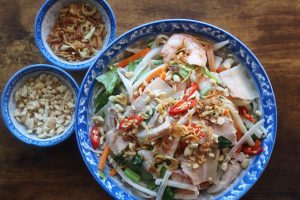
Lotus Stem Salad (with Shrimp and Pork) or Gỏi Ngó Sen Tôm Thịt is a classic Vietnamese dish that beautifully showcases the unique textures and flavours of lotus stem. Unlike the mature lotus root, which is popular in various Asian cuisines, lotus stem (ngó sen) is primarily used in Vietnamese cooking, where it’s celebrated for its light, crisp texture and delicate flavour.
Harvested young, the lotus stem retains a mild sweetness and distinctive crunch, making it ideal for salads. In this refreshing recipe, tender lotus stem pairs with succulent shrimp, savoury pork belly, and fresh herbs, all tossed in a sweet, tangy dressing. Topped with crunchy peanuts and fried shallots, Lotus Stem Salad (with Shrimp and Pork) is a vibrant blend of flavours and textures that embodies the essence of Vietnamese cuisine – fresh, balanced, and full of life.
This salad not only offers a delightful culinary experience but also packs nutritional benefits. Lotus stem is rich in dietary fibre, vitamins, and minerals, supporting both health and flavour. Perfect as an appetizer or a light meal, Lotus Stem Salad (with Shrimp and Pork) is a must-try for anyone looking to explore the authentic tastes of Vietnam.
Here are a few notes on my Lotus Stem Salad (with Shrimp and Pork) recipe:
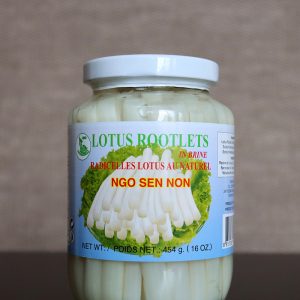 Fresh lotus stems can be a bit tricky to find, even in Asian supermarkets. However, you can often find them available in glass jars in the aisle for pantry or pickled items. For this recipe, you may need about two jars. I’ve included a picture here for easy reference!
Fresh lotus stems can be a bit tricky to find, even in Asian supermarkets. However, you can often find them available in glass jars in the aisle for pantry or pickled items. For this recipe, you may need about two jars. I’ve included a picture here for easy reference!
- You can substitute Chinese celery with regular celery, but I recommend using just the leafy parts and roughly chopping them. If you use the celery stem, it may add too much crunch, which could disrupt the intended texture and balance of flavours in the dish. The leaves will provide a similar freshness without overwhelming the other ingredients.
Q&As on Lotus Stem Salad (with Shrimp and Pork)
1. What is lotus stem?
The lotus stem is the young rhizome of the lotus plant, found deep beneath the mud in marshy ponds. As the lotus plant grows, its rhizomes spread, forming new shoots – these tender, young shoots are what we call lotus stems. Lotus stems are white, long, and cylindrical with a soft, crunchy texture and a unique hollow structure featuring tiny air pockets running the length of each stem.
Vietnamese people generally prefer to eat young lotus stems, which are slender and tubular when freshly harvested. Others enjoy lotus stems that have grown into more mature lotus roots. Many mistake lotus stems and lotus roots as two separate parts, but they are essentially one, both coming from the lotus plant’s stem.

Lotus stems are typically harvested in summer and fall, the peak growth period for the lotus plant. This is when the stems are at their crispest and most flavourful.
The harvesting process is quite meticulous and requires skill. Harvesters wade into the ponds, using their hands or special tools to carefully separate the lotus stems from the main rhizome. Once collected, the stems must be thoroughly cleaned and properly stored to retain their freshness and crunch.
2. Does lotus stem have any nutritional value?
Yes, lotus stem is quite nutritious! It’s a good source of dietary fibre, which supports digestion, and contains essential vitamins and minerals like vitamin C, potassium, and iron. It’s also low in calories, making it a healthy addition to many dishes.
3. I’ve heard Vietnamese people mention “ngó sen” and “củ sen.” Are they the same thing?
The lotus stem (ngó sen) is the lotus root (củ sen) that grows from the lotus plant’s rhizome. However, if it is harvested right after sprouting, it’s called lotus stem (ngó sen), which is the tenderest part. If we let these young stems mature and age before harvesting, they are then referred to as lotus root (củ sen).
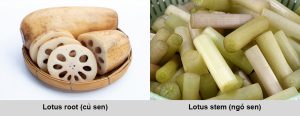
4. Is the use of lotus stem in cooking unique to Vietnamese cuisine?
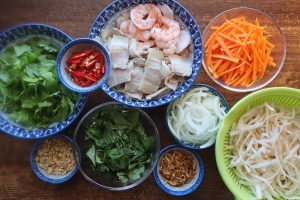
The use of lotus stem (ngó sen) in cooking is indeed a unique aspect of Vietnamese cuisine. While lotus root (củ sen) is widely used in various Asian cuisines, especially in Chinese, Japanese, and Indian dishes, the tender young lotus stem is much less common outside of Vietnam.
In Vietnam, lotus stem is prized for its light, crisp texture and mild flavour, often showcased in fresh salads like Gỏi Ngó Sen or in pickled dishes. It’s harvested before the stem matures into the thicker lotus root, making it distinct from the starchy, dense quality of mature lotus roots used elsewhere. This preference for young, fresh ingredients in Vietnamese cooking aligns well with the country’s culinary focus on crisp textures and refreshing flavours.
5. How do you pronounce “Gỏi Ngó Sen Tôm Thịt?”
Here’s how to pronounce it and what each term means:
- Gỏi – pronounced “goy” (with a rising tone, as in “goy?” like a question); it means “salad.”
- Ngó – pronounced “ngaw” (starting with a soft “ng” sound and a rising tone); this means “young shoot” or “stem.”
- Sen – pronounced “sen” (like the word “send” without the “d”); this refers to “lotus,” so “ngó sen” means “lotus stem.”
- Tôm – pronounced “tohm” (similar to “tome” as in a large book); this means “shrimp.”
- Thịt – pronounced “teet” (with a soft “t” at the end); it means “meat,” often referring to pork in Vietnamese dishes.
So, “Gỏi Ngó Sen Tôm Thịt” translates to “Lotus Stem Salad with Shrimp and Pork.” Together, it sounds like “goy ngaw sen tohm teet.”
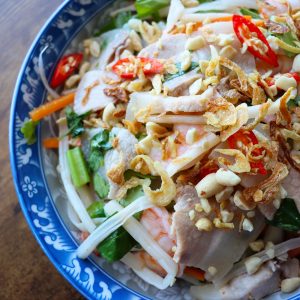
Recipe for Lotus Stem Salad (with Shrimp and Pork Belly) - Gỏi Ngó Sen Tôm Thịt
Equipment
- 1 Pot
Ingredients
- 500 grams lotus stems
- 300 grams pork belly
- 300 grams shrimp (peeled and deveined)
- 150 grams carrot
- 100 grams yellow onion
- 70 grams Chinese celery
- 20 grams Vietnamese coriander (rau răm)
- 15 grams fresh Thai chilis
For Soaking:
- 100 grams sugar
- 100 mL vinegar
For the Mixing Sauce:
- 2 tablespoons fish sauce
- 4 tablespoons sugar
- 1 tablespoon sriracha chili sauce
- 1 tablespoon lime juice
For Garnish:
- Lightly crushed peanuts
- Fried shallots
Instructions
- Prepare the Mixing Sauce:In a mixing bowl, combine the fish sauce, sugar, lime juice, and sriracha chili sauce. Stir thoroughly until the sugar has fully dissolved, creating a smooth and balanced dressing. Set aside.
- Prepare the Pork Belly and Shrimp:In a pot, bring enough water to a boil to submerge the pork belly. Once the water is boiling, add the pork belly.Allow the pork belly to cook fully, until it is tender and cooked through. Once done, remove it from the pot and immediately place it in an ice water bath to stop the cooking process. Let it soak for about 5 minutes, then take it out.Using the same pot and water, add the shrimp and cook until they just turn pink and opaque. Be careful not to overcook.Transfer the shrimp to the same ice water bath as the pork belly to cool rapidly. Let them soak for about 5 minutes, then take them out.Once cooled, slice the pork belly into thin, bite-sized pieces.Slice each shrimp in half lengthwise.
- Prepare the Vegetables:Cut each lotus stem into thin, even strands.Peel the carrot then julienne it.In a mixing bowl, combine the lotus stems with 100 grams of sugar and 100 mL of vinegar. Toss well to coat, and let this mixture sit for about 15 minutes to lightly pickle the vegetables.Slice the onion thinly. Then, soak the onion slices in ice water for about 10 minutes to reduce their sharpness, making them milder for the salad.Thinly slice the Thai chilis to add a touch of heat throughout the salad. Adjust the amount if you prefer less spice.Roughly chop the celery into small pieces.Roughly chop the Vietnamese coriander.
- Assemble the Salad:In a large mixing bowl, combine the sliced shrimp and pork belly, Thai chilis, celery, and Vietnamese coriander. Pour in a portion of the mixing sauce and toss all ingredients thoroughly to ensure they’re well coated.Remove the lotus stems from their pickling mixture, then squeeze them gently to drain any excess liquid. Add them to the mixing bowl.Add the carrots and sliced onions, then pour in the remaining sauce. Toss all ingredients together, ensuring the salad is evenly mixed and coated in the sauce.
- Serve:Transfer the finished salad to a serving plate. Garnish with fried shallots and crushed peanuts for added crunch and aroma. Your Lotus Stem Salad with Shrimp and Pork is ready to serve!

